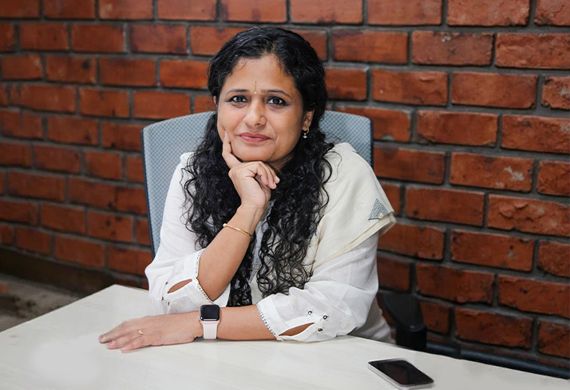
AI Revolution & Lean Six Sigma Redefining Offshore Center Excellence
By: Srividya Parthasarathy, Vice President Operations, RRD
With over 20 years in operations excellence, Srividya excels at turning strategy into actionable results using Lean, Six Sigma, and automation. She has a strong track record in process re-engineering, virtual transformation, and leading multi-domain offshore centers, fostering innovation and customer-focused growth.
In an engaging interaction with Women Entrepreneurs Review Magazine, Srividya shares her insights on how current market trends affect offshore center effectiveness, common challenges in aligning customer needs with execution, and how Lean, Six Sigma, and emerging technologies will shape offshore operations’ future.
How do you see the current market trends impacting the effectiveness of offshore centers? How can organizations ensure they remain competitive while maintaining execution rigor?
We are at the beginning of the artificial intelligence (AI) revolution, and yet we are still seeing a growing demand for skilled talent in various roles in the offshore centers. Of course, to remain relevant, Global capability centers need to continue their focus on process excellence. The first principles on which offshoring started remain true to this day. Waste creeps into every process, and GCCs need to continuously question the process, rigorously use the six sigma principles to identify waste, and build tools to eliminate, streamline, standardize, and automate processes. This is the key to remaining competitive in the current landscape. Every noteworthy capability center has invested in technology exploration in the last 10 years. This has given them the head start to delve into the AI use cases that would be most relevant for their customers.
As per a recent McKinsey report, Global interest in India is already growing. From 2021 to 2023, 984 international companies registered to operate in India, up from 320 between 2019 and 2021. There are now over 1,500 global capability centers in the country, about 60 percent of which focus on IT, business process management, or engineering, research, and development. Analysts predict that companies will create over 250 new global capability centers in India over the next three to five years. Many companies are also establishing data centers in India to gain access to skilled IT workers.
In your experience, what are the most common challenges in translating customer needs into action within offshore centers? How do you address them with Lean and Six Sigma methods?
Typically, offshore centers are layered organizations with multiple levels of management and leadership interacting with the different levels in the client organization. There are many failure points where the customer provides a lack of details, and if we fail to ask clarifying questions, the execution team runs the risk of delivering an output that falls short of the customer’s expectations.
The framework we use to capture the customer’s requirements is the most important part. Paying attention to the details, uncovering the stated and unstated needs of the client, probing to find out the purpose of the output and the variations that would be of value to the clientare the most critical part of the process. Project managers then break down these requirements into actionable work packages and brief the execution team on these thoroughly. The next stage is where the project managers receive the output and work with quality control after providing them with the full briefing. This is the two-eye check that ensures there is no miscommunication, enabling us to deliver the output as per the customer’s specifications.
Six sigma principles are used to make this process flow efficient and responsive to meet the deadlines as required by the customer. Our in-house workflow tools ensure that all details are captured at every stage of the process while alerting supervisors if there are any delays in the process. The back-end data and timestamps enable us to continuously study the process to make improvements.
Given your success in setting up Knowledge and Voice Offshore Centers, what emerging technologies or innovations do you think will shape the future of offshore operations over the next five years?
Every day, we hear something new in the world of AI. This is going to revolutionize the way offshore centers operate. The last two decades have seen emerging technologies, automation and robotic process automation (RPA), and data analytics change the offshoring landscape. This will continue. If I have to list it down, it would be:
- Artificial Intelligence (AI) and Machine Learning (ML): AI-powered systems will analyze data, make predictions, and to some extent, automate decision-making. AI-driven chatbots will provide instant responses to customer queries, improving customer experiences.
- Automation and Robotic Process Automation (RPA): RPA will continue to automate repetitive tasks, reducing processing time and human errors. Hyper automation is enabling greater productivity at lower costs and in a shorter amount of time by identifying business and IT processes that can be automated using multiple technologies.
- Conversational AI: AI will transform customer service by enabling faster, more personalized, and efficient support through computer telephony integration, contact center as a service, and self-service portals.
- Metaverse: The metaverse, a virtual and augmented reality platform, may be used to enhance customer service, improve teamwork, and create virtual stores.
- Data Analytics: Data analytics will help BPO companies make better business decisions, forecast trends, and deliver personalized services.
These technologies will drive innovation, improve efficiency, and enhance customer satisfaction in offshore centers.
With the shift towards automation and digital transformation, how do you maintain a balance between leveraging technology and fostering the human leadership elements that drive operational success?
People are at the core of all that we do. Technology aids the execution and has the potential to make it flawless. Customers communicate their requirements through discussions with our team members. It is through skillful probing and multiple rounds of discussions that it becomes clear to the customer what exactly they want.
It is going to be some while before agentic AI can probe and understand the nuances of human communication via voice inflection, body language, and unstated needs. We hence continue to invest in developing the emotional intelligence, communication, confidence, and stakeholder management skills in our leaders who interact with customers.
Similar investment is made in our young leaders who lead the teams, motivating them day in and day out to overachieve on their targets. Everyone at all levels is now comfortable with technology thanks to the indispensable smartphone. It is difficult to keep the workforce engaged with repetitive transactions. Teams embrace automation for repetitive tasks. There is still some skepticism about accepting that AI will take over all the judgment-oriented activities that knowledge centers execute. However, it is early days and the revolution has started. Leadership focus is now on orienting our workforce to use AI tools effectively and to reskill them to higher thinking and creative tasks to stay relevant in the coming years.
In scaling offshore operations, how do you measure and ensure sustained excellence across various domains like HR, Finance, and Customer Service, particularly in the context of continuous change?
Communication is the key to ensuring all teams pull in the same direction. Quoting Simon Senek, ‘People align to the ‘Why we do what we do’... so we must be clear about the ‘Why’ and this is aligned across teams, including cross-functional teams. Theoretically, we all know this; however, during the period of hyperactivity, we may neglect to clarify the why and allow gaps to form. To ensure that this does not happen, it’s important to have independent feedback mechanisms that provide us a ground-up view of how the communication/intent/initiative is received and executed.
Message for Women Leaders
Stay focused on the basics. The only focus for an operations leader, irrespective of gender, will be to ensure customer-focused quality delivery in the fastest and most efficient manner. Using data to guide our actions will ensure we do not lose sight of this focus.


.jpg)



